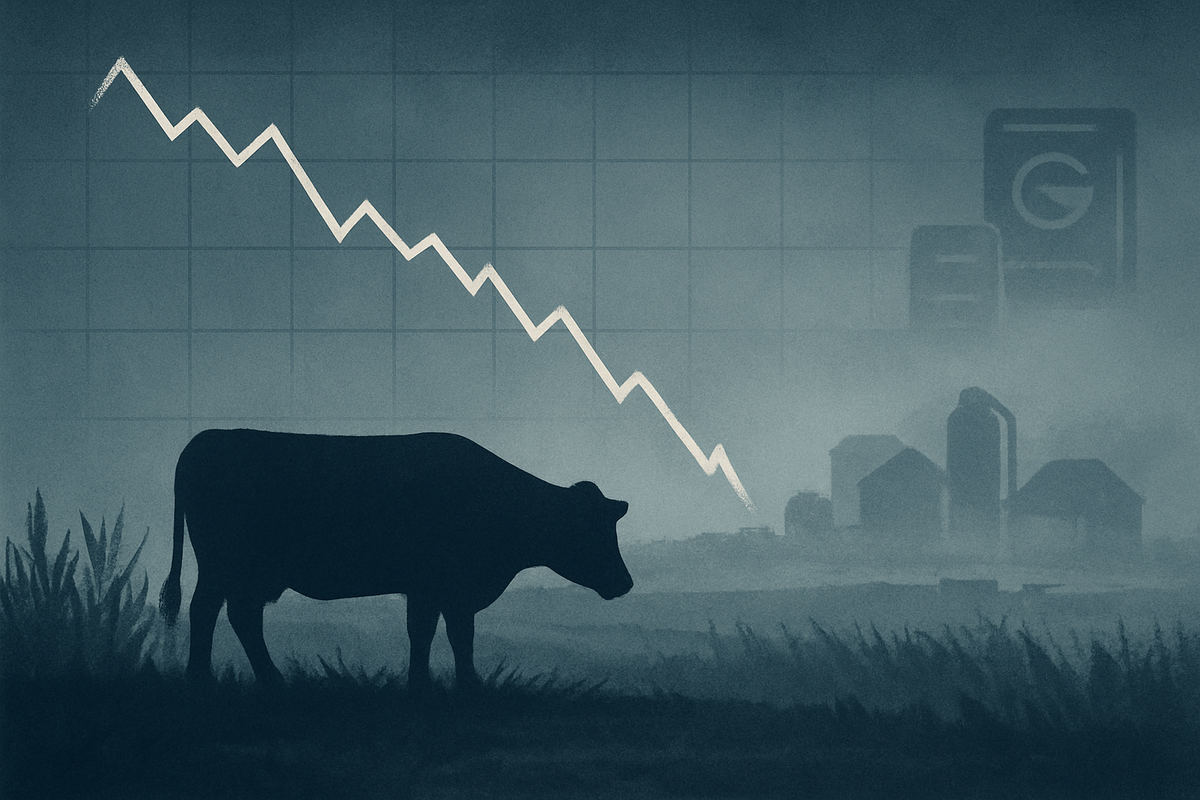
SPRINGDALE, AR – Tyson Foods (NYSE: TSN), one of the world's largest food companies, has seen its stock price plummet to a new 52-week low of $51.07, a stark indicator of significant challenges stemming from persistent "beef woes" and broader shifts within the agricultural commodity sector. This substantial downturn, observed around mid-October 2025, reflects a challenging operational environment for the meat processing giant, impacting both the company's financial performance and investor confidence.
The immediate implications of this stock plunge are multifaceted, signaling deepening losses within Tyson's crucial beef segment due to severe cattle shortages and escalating input costs. While the company is actively implementing cost-cutting measures and strategic plant closures, the market remains cautious. Investors are closely watching for signs of recovery, particularly as the company pivots towards higher-margin prepared foods and value-added products to bolster its net margins amidst flat sales volumes and uncertain chicken operations.
Detailed Coverage: Unpacking Tyson's Market Slide
The recent nosedive in Tyson Foods' (NYSE: TSN) stock to $51.07 on October 14, 2025, marks a critical point in a challenging period for the meat processing giant. This specific dip is the culmination of several adverse events and market pressures that have been building over the past year, primarily centered around its beef division. The "beef woes" are not a sudden occurrence but rather an intensification of issues that have plagued the industry, and Tyson specifically, for months.
The timeline leading up to this moment reveals a deteriorating situation. Throughout late 2024 and into 2025, the company has been battling persistent cattle shortages, which have driven up the cost of raw materials significantly. This, coupled with elevated operational expenses, has squeezed profit margins in the beef segment. In response, Tyson announced strategic plant closures in late 2024, an attempt to streamline operations and cut costs. Despite these efforts, the market reaction has been largely negative, as evidenced by the stock's consistent underperformance against the S&P 500 over the past one to three years. Further adding to the complexity, the company also announced plans to reformulate some of its U.S. branded products by removing high-fructose corn syrup and other additives by the end of 2025, a move aimed at aligning with evolving consumer preferences but also incurring associated costs.
Key players and stakeholders involved in this scenario include Tyson Foods' management, who are tasked with navigating these headwinds through operational adjustments and strategic shifts, and its investors, who are grappling with the declining stock value. The broader agricultural commodity market, including cattle ranchers and feed suppliers, also plays a crucial role, as their challenges directly impact Tyson's input costs. Initial market reactions have been characterized by analyst downgrades, with BMO Capital, for instance, reducing its price target for Tyson Foods to $53 from $58, maintaining a Market Perform rating. This cautious sentiment reflects concerns over sustained margin pressures and an uncertain near-term outlook.
The upcoming fourth-quarter 2025 earnings release, scheduled for November 10, 2025, is highly anticipated, as it will provide critical insights into the company's financial health and the effectiveness of its current strategies. Investors are hoping for a clearer path to recovery, but the immediate sentiment remains one of apprehension, highlighting the severe challenges facing Tyson's core business.
Winners and Losers: Shifting Tides in the Meat and Agricultural Sector
The struggles of Tyson Foods (NYSE: TSN) and its pronounced "beef woes" are sending ripple effects across the broader meat processing industry and the agricultural commodity sector, creating a dynamic landscape of potential winners and losers. While Tyson grapples with its challenges, other players may find opportunities, while some may face similar headwinds.
Companies with diversified protein portfolios or a stronger focus on less volatile segments could emerge as relative winners. For instance, companies heavily invested in pork or poultry, or those with robust international operations that can offset domestic market pressures, might fare better. Furthermore, companies specializing in plant-based alternatives or lab-grown meat could see increased interest as consumers and investors alike seek more sustainable and less volatile protein sources. The shift in consumer demand for convenience and value-added products, which Tyson itself is trying to capitalize on, also benefits companies that already have a strong foothold in the prepared foods segment. These companies might see an uptick in market share or investor confidence as the traditional meat processing sector faces scrutiny.
Conversely, other major meat processors, particularly those with significant exposure to the beef segment, could find themselves in a similar predicament to Tyson. Companies like JBS S.A. (BDR: JBSS3) or Cargill (privately held, but a major industry player) might also be experiencing the pressures of cattle shortages and rising input costs, albeit to varying degrees depending on their operational efficiencies and sourcing strategies. Smaller, independent meatpackers might find it even harder to absorb these increased costs, potentially leading to consolidation or closures within the industry. Beyond the processors, the event also affects cattle ranchers and feedlot operators. While cattle shortages drive up prices for those with available stock, the overall volatility and reduced demand from processors could create an unstable market for producers, impacting their long-term investment and breeding decisions.
The broader agricultural commodity sector also feels the impact. Grains like corn and soy, which are primary feed ingredients, could see fluctuating demand and prices. If meat production declines or shifts, the demand for these commodities could also change, affecting agricultural giants like Archer-Daniels-Midland (NYSE: ADM) or Bunge Global SA (NYSE: BG). Overall, the event underscores a period of significant recalibration within the food industry, where agility, diversification, and strategic adaptation will be key determinants of success.
Wider Significance: A Bellwether for Industry Transformation
Tyson Foods' (NYSE: TSN) precipitous stock decline is more than just a corporate setback; it serves as a potent bellwether for broader, transformative trends sweeping across the agricultural commodity and food processing industries. The "beef woes" experienced by Tyson—characterized by cattle shortages and soaring input costs—are not isolated incidents but rather symptoms of systemic shifts driven by climate change, evolving consumer preferences, and increasing supply chain vulnerabilities. This event underscores the growing pressure on traditional protein producers to adapt to a rapidly changing global food system.
The potential ripple effects on competitors and partners are substantial. Other large-scale meat processors, even those with diverse portfolios, are likely scrutinizing their own beef operations and supply chains for similar vulnerabilities. The challenges faced by Tyson could accelerate industry consolidation, as smaller players struggle to compete against the economic headwinds. Furthermore, partners in the supply chain, from feed suppliers to distributors and retailers, will need to adjust to potential shifts in production volumes, pricing, and product offerings. The push towards higher-margin, value-added products and prepared foods, exemplified by Tyson's strategic pivot, signals a broader industry trend where profitability is increasingly found in processed and branded goods rather than raw commodities.
Regulatory and policy implications are also significant. Governments and international bodies may face renewed calls to address issues such as food security, sustainable agricultural practices, and animal welfare, especially as supply chain disruptions become more frequent. Policies related to land use, environmental regulations, and trade agreements could be influenced by the ongoing challenges in the meat industry. Historically, the agricultural sector has always been susceptible to cycles of supply and demand, weather events, and disease outbreaks. However, the current confluence of factors—including rapid climate shifts, a global pandemic's lingering effects on labor and logistics, and a growing consumer appetite for diverse protein sources—suggests that the current challenges are more profound than typical cyclical downturns. Comparisons might be drawn to past periods of significant agricultural disruption, such as the 1970s oil shocks impacting farming costs or major disease outbreaks leading to widespread culling, but the current scenario presents a unique blend of environmental, economic, and societal pressures.
Ultimately, Tyson's struggles highlight the urgent need for innovation and resilience within the food sector. It signals a move away from purely commodity-driven models towards more integrated, sustainable, and consumer-centric approaches, pushing the entire industry towards a necessary transformation.
What Comes Next: Navigating a Shifting Landscape
The path forward for Tyson Foods (NYSE: TSN) and the broader meat processing industry is marked by both significant challenges and potential opportunities. In the short term, the company's immediate focus will undoubtedly be on its upcoming fourth-quarter 2025 earnings report on November 10, 2025. This report will be crucial in demonstrating the effectiveness of its current cost-cutting and efficiency initiatives, particularly within the beleaguered beef segment. Investors will be keenly watching for any signs of margin improvement or stabilization, as well as updates on the performance of its chicken and prepared foods divisions. Strategic pivots towards higher-margin products, such as Tyson Chicken Cups and new Hillshire Farm flavors, will need to show tangible results to restore investor confidence.
In the long term, Tyson will likely need to continue its strategic re-evaluation, potentially leading to further diversification of its protein portfolio and an intensified focus on sustainable and resilient supply chains. This could involve greater investment in alternative protein sources, enhanced automation in processing plants to mitigate labor costs and shortages, and more sophisticated risk management strategies to hedge against commodity price volatility and climate-related disruptions. The company's commitment to removing high-fructose corn syrup and other additives from its U.S. branded products by the end of 2025 also indicates a longer-term strategy to align with evolving consumer health trends and capture a broader market segment.
Market opportunities or challenges that may emerge include the potential for industry consolidation if smaller, less resilient players succumb to the pressures. This could present acquisition opportunities for stronger companies, albeit with regulatory scrutiny. Conversely, the challenges faced by traditional meat processors could accelerate the growth of the plant-based and lab-grown meat sectors, creating new competitive pressures. Potential scenarios and outcomes range from a gradual recovery for Tyson, driven by successful strategic execution and a stabilization of commodity markets, to a more prolonged period of underperformance if the "beef woes" and broader market dynamics prove to be more entrenched than anticipated. The company's ability to innovate, adapt its business model, and effectively communicate its strategy to investors will be paramount in determining its trajectory.
Comprehensive Wrap-up: A Critical Juncture for Tyson and the Industry
The plunge of Tyson Foods' (NYSE: TSN) stock to a new 52-week low is a significant event, underscoring a critical juncture not only for the company but for the entire agricultural commodity and food processing industry. The key takeaways from this downturn are the profound impact of "beef woes," driven by cattle shortages and escalating input costs, and the urgent need for strategic adaptation in a rapidly shifting market. Tyson's efforts to streamline operations, cut costs, and pivot towards higher-margin prepared foods are commendable, but their effectiveness remains to be fully seen. The consistent underperformance against the S&P 500 highlights that these are not minor adjustments but fundamental challenges to its core business model.
Moving forward, the market will be assessing Tyson Foods' resilience and its ability to navigate a complex environment characterized by fluctuating consumer demand, supply chain vulnerabilities, and evolving sustainability pressures. The upcoming earnings report on November 10, 2025, will be a crucial indicator of the company's short-term health and the initial success of its strategic initiatives. Beyond financial metrics, investors and industry observers will be watching for signs of innovative solutions to supply chain issues, further diversification of protein sources, and a sustained commitment to meeting changing consumer preferences, such as the reformulation of branded products.
The lasting impact of this event could be a catalyst for broader industry transformation. It serves as a powerful reminder that even established giants like Tyson Foods are not immune to the forces of market disruption and environmental change. For investors, the situation presents both risks and potential opportunities. While the stock's undervaluation and consistent dividend payments may appeal to value investors, the underlying operational challenges warrant careful consideration. In the coming months, investors should closely watch for improvements in beef segment margins, the growth trajectory of prepared foods, and any further strategic announcements that signal a robust long-term vision for navigating the evolving landscape of global food production.
This content is intended for informational purposes only and is not financial advice





